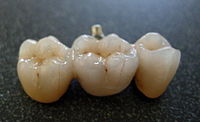
Photo from wikipedia
Implant-supported crowns remain an ideal treatment option for the replacement of a missing tooth. The provisionalization phase remains a critical step between surgery and final crown placement, guiding soft tissue… Click to show full abstract
Implant-supported crowns remain an ideal treatment option for the replacement of a missing tooth. The provisionalization phase remains a critical step between surgery and final crown placement, guiding soft tissue healing and providing esthetics and function. Although there are several possible pathways for provisionalization, the options are time-consuming, technically difficult and expensive, resulting in confusion and frustration for the dentist and cost and time for the patient. A novel dental implant abutment has been developed that aims to resolve the shortcomings of current abutments and the provisionalization process. 3D printing or additive manufacturing, with plastic and metal, were employed as an alternative approach for production of the prototype abutment. Scanning, computer-aided design and 3D plastic and metal printing were employed. Abutments were fabricated in MED690 VeroDentPlus and Duraform 316L stainless steel, respectively. Prototypes were printed with a claimed accuracy of 16 µm (plastic) and 8 µm (metal). The prototypes were qualitatively assessed for functionality by implant threading and simulated provisionalization process in a laboratory setting. The plastic prototypes were not suitable due to threading issues and material weakness. Metal prototypes tolerated artificial tooth fabrication successfully but concerns with thread pitch and accuracy remained. 3D metal printing appears to be a suitable alternative to traditionally machined implant components; however, post-production processing seems to be required. Further research is warranted.
Journal Title: Journal of Dental Research, Dental Clinics, Dental Prospects
Year Published: 2018
Link to full text (if available)
Share on Social Media: Sign Up to like & get
recommendations!